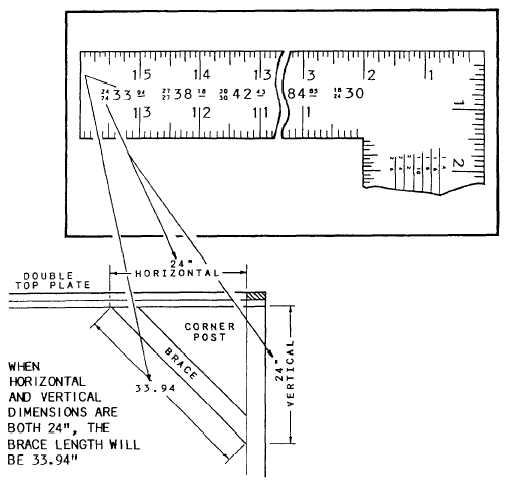Figure 2-11.-Brace table.
brace table, located on the back of the tongue; and the
Essex board measure table, located on the back of the
blade. Before you can use the unit length rafter table,
you must be familiar with the different types of rafters
and with the methods of framing them. The use of the
unit length rafter table is described later in this chapter.
The other two tables are discussed below.
Brace
The brace table sets forth a series of equal runs and
rises for every three-units interval from 24/24 to 60/60,
together with the brace length, or length of the
hypotenuse, for each given run and rise. The table can
be used to determine, by inspection, the length of the
hypotenuse of a right triangle with the equal shorter
sides of any length given in the table. For example, in
the segment of the brace table shown in figure 2-11, you
can see that the length of the hypotenuse of a right
triangle with two sides 24 units long is 33.94 units; with
two sides 27 units long, 38.18 units; two sides 30 units
long, 42.43 units; and so on.
By applying simple arithmetic, you can use the
brace table to determine the hypotenuse of a right
triangle with equal sides of practically any even-unit
length. Suppose you want to know the length of the
hypotenuse of a right triangle with two sides 8 inches
long. The brace table shows that a right triangle with two
sides 24 inches long has a hypotenuse of 33.94 inches.
Since 8 amounts to 24/3, a right triangle with two shorter
sides each 8 inches long must have a hypotenuse of
33.94 ÷3, or approximately 11.31 inches.
Suppose you want to find the length of the
hypotenuse of a right triangle with two sides 40 inches
each. The sides of similar triangles are proportional, and
any right triangle with two equal sides is similar to any
other right triangle with two equal sides. The brace table
shows that a right triangle with the two shorter sides
2-8

